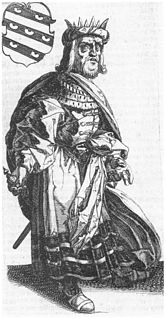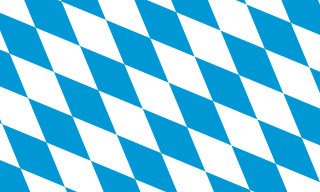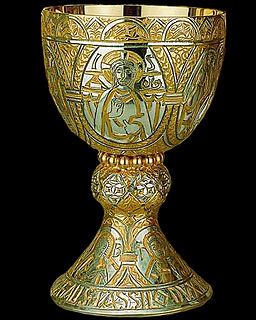Sources
| Preceded by Theodo | Duke of Bavaria c.716 – c.719 | Succeeded by Grimoald |
| This article about a member of the German nobility is a stub. You can help Wikipedia by expanding it. |
Tassilo II (died c. 719) was a ruler in southern Germany.
He was the son, probably third, of Theodo of Bavaria and Folchaid. Sometime before 715, Theodo divided his duchy and associated with its rule the eldest two of his four sons. The eldest, Theodbert, was co-ruling as early as 702 and the second, Theobald, from 711. On Theodo's death (probably in 716), the division took full effect. It is not known if the division was territorial (as with the Merovingians) or purely a co-regency (as with the later princes of Benevento and Capua). If the former, it seems to have followed the fourfold ecclesiastic division into dioceses which Theodo had effected. If that is the case, it is most probable that Tassilo ruled the diocese of Passau with his capital there at its see.
War broke out between the brothers soon after their father's death, but few details are known. About Tassilo's time as duke, next to nothing is known. His existence is confirmed in the "Codex of Salzburg" (Salzburger Verbrüderungsbuch ) where he is listed as unmarried, though some surmise that a certain Waldrada, mentioned as a wife of Theobald, was in fact Tassilo's. On the other hand, he is identified as the husband of Imma (d. c. 750), by whom he had Grimoald and Swanachild. Through Swanachild, Tassilo would be the father-in-law of Charles Martel. Because Swanachild is with certainty the niece of duke Odilo, one would be forced to assume that Odilo was brother or brother-in-law to Tassilo. Tassilo was dead by 719, as were all his brothers save Grimoald.
| Preceded by Theodo | Duke of Bavaria c.716 – c.719 | Succeeded by Grimoald |
| This article about a member of the German nobility is a stub. You can help Wikipedia by expanding it. |

Year 719 (DCCXIX) was a common year starting on Sunday of the Julian calendar. The denomination 719 for this year has been used since the early medieval period, when the Anno Domini calendar era became the prevalent method in Europe for naming years.

Pepin II, commonly known as Pepin of Herstal, was a Frankish statesman and military leader who de facto ruled Francia as the Mayor of the Palace from 680 until his death. He took the title Duke and Prince of the Franks upon his conquest of all the Frankish realms.

Carloman was the eldest son of Charles Martel, majordomo or mayor of the palace and duke of the Franks, and his wife Chrotrud of Treves. On Charles's death (741), Carloman and his brother Pepin the Short succeeded to their father's legal positions, Carloman in Austrasia, and Pepin in Neustria. He was a member of the family later called the Carolingians and it can be argued that he was instrumental in consolidating their power at the expense of the ruling Merovingian kings of the Franks. He withdrew from public life in 747 to take up the monastic habit, "the first of a new type of saintly king," according to Norman Cantor, "more interested in religious devotion than royal power, who frequently appeared in the following three centuries and who was an indication of the growing impact of Christian piety on Germanic society".
The Carolingian dynasty was a Frankish noble family founded by Charles Martel with origins in the Arnulfing and Pippinid clans of the 7th century AD. The dynasty consolidated its power in the 8th century, eventually making the offices of mayor of the palace and dux et princeps Francorum hereditary, and becoming the de facto rulers of the Franks as the real powers behind the Merovingian throne. In 751 the Merovingian dynasty which had ruled the Germanic Franks was overthrown with the consent of the Papacy and the aristocracy, and Pepin the Short, son of Martel, was crowned King of the Franks. The Carolingian dynasty reached its peak in 800 with the crowning of Charlemagne as the first Emperor of Romans in the West in over three centuries. His death in 814 began an extended period of fragmentation of the Carolingian Empire and decline that would eventually lead to the evolution of the Kingdom of France and the Holy Roman Empire.

Daufer was a king of the Lombard Kingdom of northern Italy, ruling from 756 to 774. He is chiefly known for his connection to Charlemagne, who married his daughter and conquered his realm.

Francia, also called the Kingdom of the Franks, or Frankish Empire, was the largest post-Roman barbarian kingdom in Western Europe. It was ruled by the Franks during Late Antiquity and the Early Middle Ages. It is the predecessor of the modern states of France and Germany. After the Treaty of Verdun in 843, West Francia became the predecessor of France, and East Francia became that of Germany. Francia was among the last surviving Germanic kingdoms from the Migration Period era before its partition in 843.

Sigebert III was the Merovingian king of Austrasia from 633 to his death around 656. He was described as the first Merovingian roi fainéant —do-nothing king—, in effect the mayor of the palace ruling the kingdom throughout his reign. However he lived a pious Christian life and was later sanctified, being remembered as Saint Sigebert of Austrasia in the Roman Catholic Church and Eastern Orthodox Church.

The Duchy of Bavaria was a frontier region in the southeastern part of the Merovingian kingdom from the sixth through the eighth century. It was settled by Bavarian tribes and ruled by dukes (duces) under Frankish overlordship. A new duchy was created from this area during the decline of the Carolingian Empire in the late ninth century. It became one of the stem duchies of the East Frankish realm which evolved as the Kingdom of Germany and the Holy Roman Empire.

Liutprand was the King of the Lombards from 712 to 744 and is chiefly remembered for his Donation of Sutri, in 728, his multiple phases of law-giving, in fifteen separate sessions from 713 to 733 inclusive, and his long reign, which brought him into a series of conflicts, mostly successful, with most of Italy. He is often regarded as the most successful Lombard monarch, notable for the Donation of Sutri, which was the first accolade of sovereign territory to the Papacy.

The Agilolfings were a noble family that ruled the Duchy of Bavaria on behalf of their Merovingian suzerains from about 550 until 788. A cadet branch of the Agilolfings also ruled the Kingdom of the Lombards intermittently from 616 to 712. They are mentioned as the leading dynasty in the Lex Baiuvariorum. Their Bavarian residence was at Regensburg.

Tassilo III was the duke of Bavaria from 748 to 788, the last of the house of the Agilolfings.
Odilo, also Oatilo or Uatilo of the Agilolfing dynasty was Duke of Bavaria from 736 until his death. He had the Lex Baiuvariorum compilation edited, the first ancient Germanic law collection of the Bavarians.
Regintrud, also known as Reginlind and Regentrud, probably was the wife of Duke Theodbert of Bavaria or of his father Duke Theodo of Bavaria. A possibly identical Regintrud became abbess of Nonnberg Abbey in 720–725. However, details about her ancestry and life are widely disputed among historians.
Theodbert was the duke of Bavaria in some capacity or other from 702 to his death. He was the eldest son of Duke Theodo of Bavaria and Folchaid. He was first associated with his father as duke in 702, ruling from Salzburg. In 711, his younger brother Theobald was co-ruling as well and his father was making plans for a fourfold division of the duchy on his death. Sometime before 715, the division was given, but whether territorial or coregent is not known. If the former, the dioceses set up by Theodo probably corresponded to the duchies of his sons. In that scenario, Theodbert probably had his seat at Salzburg, as since 702.
Swanachild was the second wife of Charles Martel, who brought her back from his first campaign in Bavaria in 725, along with her uncle Grimoald's wife, Biltrude. Swanachild belonged to the clan of the Agilolfings though her parentage is not quite clear. Her parents could be:
Grimoald was the duke of Bavaria from about 715 to his death. He was the youngest of the four sons of Theodo of Bavaria and his wife Folchaid and the uncle of Swanachild, the second wife of Charles Martel. At first, he co-reigned with his brothers Theodbert, Theobald, and Tassilo II and then, from around 719, alone. His father divided the principality, after involving his two eldest sons with the reign of the duchy in 715. Upon Theodo's death in 716, the divided duchy was plunged into civil war and all the brothers save Grimoald were dead by 719. It is not certain if the division of the duchy was territorial or a powersharing scheme, but if the former, it seems most probable that Grimoald's capital was either Freising, which he later favoured as a diocesan seat, or Salzburg, which he later treated as a capital of sorts.
Theobald was the duke of Bavaria from at least 711, when his father Theodo associated him with his rule at Passau or Salzburg. He was the second son of Theodo and Folchaid.

Theodo also known as Theodo V and Theodo II, was the Duke of Bavaria from 670 or, more probably, 680 to his death. It is with Theodo that the well-sourced history of Bavaria begins. He strengthened his duchy internally and externally and, according to the medieval chronicler Arbeo of Freising, he was a prince of great power whose fame extended beyond his borders.
Garibald II (585–625) was Duke of Bavaria from 610 until his death. He was the son of Tassilo I.
The Series ducum Bavariae, subtitled, a Theodone usque ad annum 1244, is a regnal list of the Duchy of Bavaria compiled in the middle of the thirteenth century. As its subtitle implies, it covers the succession to the duchy from a semi-legendary "Theodo I" in 514 to 1244, when Otto II Wittelsbach was duke. It was first edited in 1879 by Georg Waitz for the Monumenta Germaniae Historica.